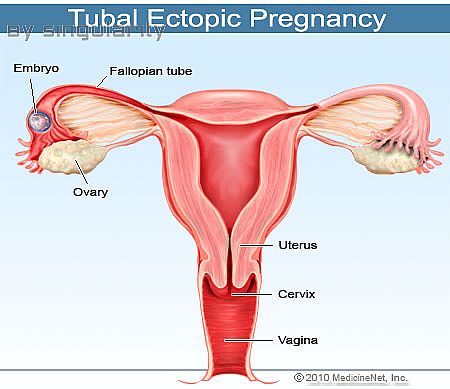

An ectopic pregnancy (EP) is a condition in which a fertilized egg settles and grows in any location other than the inner lining of the uterus. The vast majority of ectopic pregnancies are so-called tubal pregnancies and occur in the Fallopian tube. However, they can occur in other locations, such as the ovary, cervix, and abdominal cavity. An ectopic pregnancy occurs in about one in 1%-2% of all pregnancies. A molar pregnancy differs from an ectopic pregnancy in that it is usually a mass of tissue derived from an egg with incomplete genetic information that grows in the uterus in a grape-like mass that can cause symptoms to those of pregnancy.
The major health risk of ectopic pregnancy is rupture leading to internal bleeding. Before the 19th century, the mortality rate (death rate) from ectopic pregnancies exceeded 50%. By the end of the 19th century, the mortality rate dropped to five percent because of surgical intervention. Statistics suggest with current advances in early detection, the mortality rate has improved to less than five in 10,000. The survival rate from ectopic pregnancies is improving even though the incidence of ectopic pregnancies is also increasing. The major reason for a poor outcome is failure to seek early medical attention. Ectopic pregnancy remains the leading cause of pregnancy-related death in the first trimester of pregnancy.
In rare cases, an ectopic pregnancy may occur at the same time as an intrauterine pregnancy. This is referred to as heterotopic pregnancy. The incidence of heterotopic pregnancy has risen in recent years due to the increasing use of IVF (in vitro fertilization) and other assisted reproductive technologies (ARTs). For additional diagrams and photos, please see the last reference listed below.
